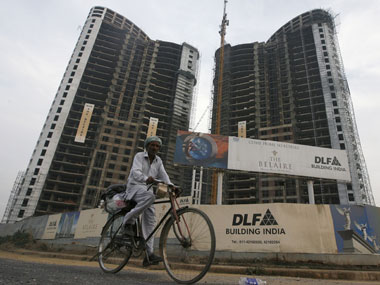What is it about real estate that any effort to sanitise its reality ends up raising a bigger stink?
Firstpost ran a report last week showing how real estate companies have destroyed value to the tune of over Rs 2,66,000 crore (down 85%, five times more than the fall in the BSE Sensex, since January 2008). Apparently, a significant chunk of the value from high real estate prices has been captured outside the balance-sheet.
A close scrutiny of some recent research reports by brokerage houses shows that even the experts are foxed by the kind of numbers put out by listed real estate companies.
[caption id=“attachment_29526” align=“alignleft” width=“380” caption=“According to the analyst, steel and cement account for 40% of DLF’s total construction cost.Reuters”]  [/caption]
Take a recent Citigroup Global Markets report dated June 20 titled “Cost inflation a big challenge - Or is it shrinking volumes?” The headline itself is a dead giveaway, for it indicates that the analyst is not quite sure why the sector is doing so badly. Is it because of higher cement and steel prices, or because few are buying at inflated values?
A look at the cost numbers tells you why. According to the analyst, steel and cement account for 40% of DLF’s total construction cost. Adding labour, we arrive at 70% as the total civil construction cost as a proportion of the total (excluding land, one presumes).
Impact Shorts
More ShortsSo far, so good. But let’s move on to Oberoi Realty, a Mumbai-based upmarket realtor. According to Citi, his steel and cement costs are just 16% of the total, and overall civil construction costs are 46%. Assuming that steel costs cannot vary so much across the country, why does an upmarket builder in Mumbai have lower costs than DLF in Delhi?
It is highly unlikely that the cement and steel used by the two are widely varying in quality to make DLF’s cost structure two-and-a-half times Oberoi’s.
Something’s fishy here.
But there’s more. According to the same report, Prestige Estates’ steel and cement costs are 25% of total construction cost, and civil costs are 47% - not too different from Oberoi’s total, except for the steel/cement differential. Where is Prestige buying its steel and cement from that it costs nearly 10% more?
In the case of Godrej Properties, which is largely based in Mumbai, the steel and cement costs are 30% of total construction costs, while civil costs (which means steel, cement and labour) are 60-65% of the overall construction cost.
Is Godrej paying more for labour than Oberoi or Prestige? How is it possible that steel and cement costs can vary from as little of 16% to a mid-range of 25-30% and top out at 40% for a DLF? Who’s doing the funny accounting? Or are we missing something here? Like land costs being lumped into the construction cost?
This question does not seem to have occurred to the Citi analyst, or, if it did, he appears to have rationalised it in some way. Nor has it stopped him from recommending DLF, Prestige and Oberoi as his top stock picks.
In fact, paradox is what marks the brokerage reports of most analysts. Another report, by Ashutosh Narkar of HSBC Global Research, and dated June 13, notes that few people are buying and prices are high. Yet it predicts that few developers will lower prices due to low inventories. It picks HDIL, a Mumbai-based slum redeveloper, as its pick because its projects are more competitively priced.
Says Narkar: “Recent data released by PE Analytics highlight that while volume growth (y-o-y) across five of the seven (major) cities continued to decelerate during Q4 FY11 (January-March 2011), inventory levels across all major cities continued to remain low…Hence despite popular anticipation, we believe developers are unlikely to cut prices in a hurry.”
A more interesting research report comes from Deutsche Bank, which has gone deeper into the problems of the sector before still recommending a buy. The report, by Abhay Shanbhag and Mayank Kankaria, is titled “On the cusp of a bounce-back, upgrading to Outperform,” and dated June 8.
Right through the report, the analysts lament the poor corporate governance of real estate companies, their varying methods of recognising revenues and costs, their opaque policies on valuing land banks, and how there is an excess of office space and sales volumes are low.
But they have still upgraded the sector to a clear buy. Reason: the share performance has been so bad, that there are now few risks left in buying real estate stocks! “The perceived peaking of rate hikes by the RBI… and price cuts by developers in the next six months could be the long-awaited catalysts for the sector,” the duo conclude.
Not that they are painting a rosy picture. They agree that there is an oversupply in commercial property, and this could continue for another 18 months. They also agree that residential properties are not moving like hot cakes, and developers are delaying deliveries to hapless buyers by 1.5-3 years on an average, but they have a neat solution for this: buy these shares after cutting price targets significantly.
The Deutsche Bank analysts say that they are cutting price targets for realty companies by 8-40% from their previous levels, which should leave enough margin for gains even if stocks fall further.
Thus DLF’s target has been cut from Rs 300 to 275, HDIL from Rs 340 to Rs 225, Indiabulls Real Estate from Rs 290 to Rs 175, Puravankara from Rs 108 to Rs 90, Sobha from Rs 425 to Rs 350, and Unitech from Rs 64 to Rs 40.
None of these shares (barring Puravankara) is anywhere near their target prices.


)

)
)
)
)
)
)
)
)



